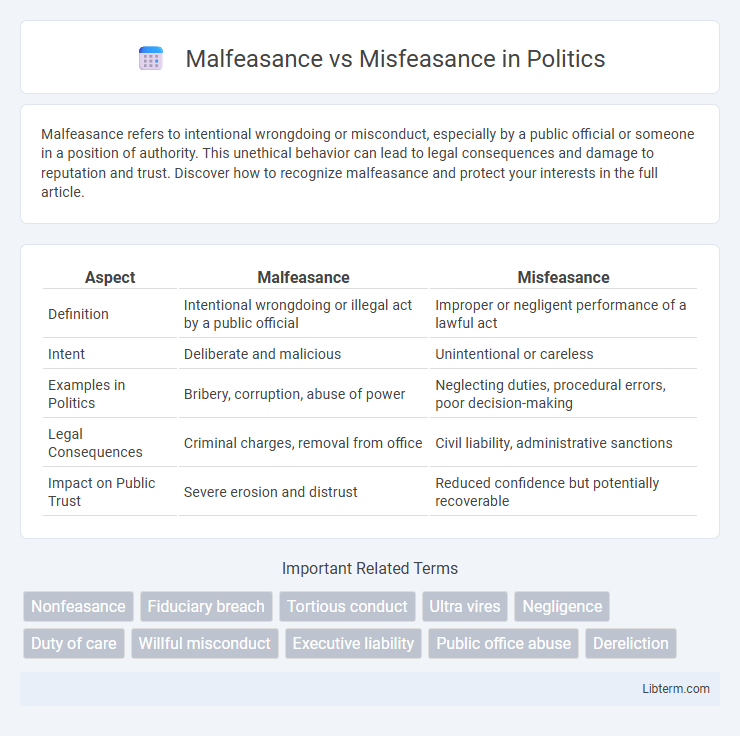Malfeasance refers to intentional wrongdoing or misconduct, especially by a public official or someone in a position of authority. This unethical behavior can lead to legal consequences and damage to reputation and trust. Discover how to recognize malfeasance and protect your interests in the full article.
Table of Comparison
| Aspect | Malfeasance | Misfeasance |
|---|---|---|
| Definition | Intentional wrongdoing or illegal act by a public official | Improper or negligent performance of a lawful act |
| Intent | Deliberate and malicious | Unintentional or careless |
| Examples in Politics | Bribery, corruption, abuse of power | Neglecting duties, procedural errors, poor decision-making |
| Legal Consequences | Criminal charges, removal from office | Civil liability, administrative sanctions |
| Impact on Public Trust | Severe erosion and distrust | Reduced confidence but potentially recoverable |
Understanding Malfeasance and Misfeasance
Malfeasance refers to intentional conduct that is harmful, illegal, or wrongful, especially by a public official or someone in a position of authority, while misfeasance involves the improper performance of a lawful act that causes harm or injury. Understanding malfeasance requires recognizing deliberate actions that breach legal or ethical standards, whereas misfeasance centers on negligent or careless execution rather than intent. Legal distinctions between these torts are crucial for addressing liability in cases of administrative or professional misconduct.
Definitions: Malfeasance Explained
Malfeasance refers to the intentional wrongdoing or unlawful conduct by a public official or employee, typically involving abuse of power or violation of legal or ethical duties. Unlike misfeasance, which involves improper or negligent performance of a lawful act, malfeasance explicitly requires a willful act of misconduct or illegal behavior. Examples of malfeasance include bribery, fraud, and embezzlement committed by government officials or corporate executives.
Definitions: Misfeasance Explained
Misfeasance refers to the improper performance of a lawful act, causing harm or damage due to negligence or carelessness. This contrasts with malfeasance, which involves the commission of an unlawful or wrongful act. Understanding misfeasance is crucial in legal contexts where a duty is owed, and the breach of that duty leads to unintended but harmful consequences.
Key Differences Between Malfeasance and Misfeasance
Malfeasance refers to the intentional execution of an unlawful or wrongful act, often involving corruption, fraud, or abuse of power. Misfeasance involves the improper or negligent performance of a lawful act, resulting in harm or damage due to carelessness or incompetence. The key difference lies in intent: malfeasance is deliberate wrongdoing, while misfeasance is a failure to perform duties correctly despite lawful authority.
Legal Context of Malfeasance
Malfeasance refers to the intentional commission of an unlawful act, especially by a public official, resulting in harm or damage, distinguishing it from misfeasance, which involves the improper performance of a lawful act. In legal contexts, malfeasance constitutes a serious violation of duty and is often grounds for civil or criminal liability, including charges of corruption or breach of public trust. Courts commonly address malfeasance through lawsuits or disciplinary actions to uphold accountability and protect public interest.
Legal Context of Misfeasance
Misfeasance in the legal context refers to the improper or unlawful performance of a lawful act, often resulting in harm or damage. It differs from malfeasance, which involves the commission of an illegal or wrongful act, while misfeasance signifies negligence or incompetence in executing a duty. Courts typically address misfeasance by examining breach of duty and resultant damages within civil liability claims.
Real-World Examples of Malfeasance
Malfeasance involves intentional wrongdoing or unlawful acts, such as embezzlement by a corporate executive who deliberately misappropriates company funds for personal gain. An example is a public official accepting bribes to secure contracts, directly violating ethical and legal standards. These acts contrast with misfeasance, which refers to lawful actions performed improperly, causing unintended harm rather than deliberate damage.
Real-World Examples of Misfeasance
Misfeasance involves the improper or negligent performance of a lawful act, such as a government official failing to maintain public infrastructure, leading to accidents or damages. Real-world examples include a city council member who approves a construction project without proper environmental assessments, causing harm to local ecosystems. Unlike malfeasance, which entails intentional wrongdoing, misfeasance centers on carelessness or errors in executing duties, often resulting in liability for damages.
Consequences and Liabilities
Malfeasance involves intentional wrongdoing or misconduct, resulting in severe legal consequences such as criminal charges, civil lawsuits, and significant financial penalties. Misfeasance, characterized by improper or negligent performance of a lawful act, typically leads to civil liabilities including damages and compensation claims but rarely criminal prosecution. Both malfeasance and misfeasance expose individuals or organizations to reputational harm and regulatory sanctions, with malfeasance attracting harsher penalties due to its deliberate nature.
Preventing Malfeasance and Misfeasance in Organizations
Preventing malfeasance and misfeasance in organizations requires implementing robust internal controls and ethical guidelines that promote transparency and accountability. Regular audits, comprehensive employee training on legal and ethical standards, and establishing clear reporting mechanisms help detect and deter wrongful or negligent conduct. Effective governance frameworks create a culture of integrity, reducing the risk of intentional wrongdoing and careless performance within organizations.
Malfeasance Infographic

 libterm.com
libterm.com